Flossing
Flossing is a vital part of any dental hygiene routine. It helps to remove food debris from the teeth and along with toothbrushing and a mouthwash reduces the risk of gum disease and tooth decay.
This is even more important as there is an increased risk of heart disease or a stroke as a result of poor oral hygiene. This means that it is more important than even to clean your teeth.
Many people brush their teeth but do not think about flossing or consider it irrelevant. But dental floss is useful at removing those bits of food which lodge between the teeth and cannot be removed by a toothbrush.
What is dental floss?
This is thin piece of thread which is made from nylon or plastic which is available in different versions. These include waxed, unwaxed and woven floss. Another version is dental tape which is thicker than standard floss.
There is also flavoured and unflavoured dental floss. The floss you choose depends upon personal choice.
An alternative to flossing is the interdental brush which achieves the same results. This is also known as interproximal brushing.
Using dental floss
Flossing should be carried out twice daily. It should be done after you have brushed your teeth and before you use a mouthwash.
The ideal way of using dental floss is as follows:
- Choose your dental floss
- Break off a piece which is around 18 inches in length
- Wrap one end of this floss around your middle finger
- Wrap the other end around the middle finger of your other hand.
- You should have a taut piece of floss between both fingers
- Grip the floss tightly between your finger and thumb and insert it into the gap between your teeth.
- Move the floss in a series of forwards and backwards motions between your teeth.
- Repeat these movements in both the upper and lower teeth
- Make sure that you rub the floss against the back as well as the sides of a tooth.
Discard the floss when you have finished using it.
If you find it difficult to use dental floss, for example you have arthritis in your hands then use a device called a ‘dental flosser’. This holds the floss and vibrates as you use it which also massages your gums gently.
There are also flossing holders/sticks and handles. All of these are designed to make it easier to use floss and can be used by adults and children.
Can you use dental floss with a brace?
It is possible to use floss with a brace but extra needs to be taken. The floss must be carefully inserted around the brace but avoid excessive pressure as this may damage the structure, e.g. wire, of the brace.
It takes longer to do so and requires a fair degree of patience but the results are worthwhile.
Dental
Information Guide
- Cosmetic
- Porcelain veneers
- Direct composite veneers
- Cosmetic crowns
- Cosmetic bridges
- Cosmetic fillings
- Direct composite bonding
- Cosmetic orthodontics
- General dentistry
- Dental Fear
- Dental implants
- Endodontic root treatments
- Orthodontics
- Invisible braces
- Fast Acting Braces
- Cosmetic braces
- Conventional orthodontic treatment
- Braces for children
- Tooth decay
- Dental hygiene
- Toothpastes and mouthwash
- Toothbrushing
- Flossing
- Interproximal brushing
- Dental treatment abroad
- Resolving problems
Cosmetic
General dentistry
Dental Fear
Dental implants
Endodontic root treatments
Orthodontics
Tooth decay
Dental hygiene
Latest news
-
Lorem ipsum dolor amet
13 OCT 2010Mauris eros sapien, mollis et varius vitae, mollis id augue...
-
Lorem ipsum dolor amet
13 OCT 2010Mauris eros sapien, mollis et varius vitae, mollis id augue...
-
Lorem ipsum dolor amet
13 OCT 2010Mauris eros sapien, mollis et varius vitae, mollis id augue...
the charity Smile Train
in conjunction with
There is No Perfect Dentist
 Buy The Book
Buy The Book
 Download a
Download a Listen to a
Listen to a  View our
View our